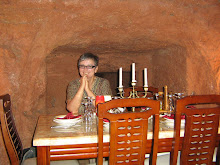
I spent a week delving into the pre-history of Malta and Gozo with the help of a visiting British archaeologist, David Trump, who has written one of the definitive books in this area - "Malta: Pre-history and Temples." He has been researching in Malta since the 1950s and continues to return each year and lead a series of site visits and seminars. The week long programme was part of a longer cultural festival in October/November organised by the Festival Mediterranea and based at Teatru Astra in Victoria in Gozo.
When I phoned to book, the four Hypogeum visits were already booked out. For conservation purposes, numbers visiting this underground burial place at Tarxien are restricted, so I will have to visit another time when I have worked out how to book on the website. So on the first day of the week, I fronted up to a meeting place to visit Kordin temple and then Tarxien. I worked out where to get off the bus to Valletta from Marsaxlokk and drew on my experience from walking to the three cities from Valletta in order to find the church opposite the Mosque and next to the Trade School. The side gate to the Trade School, where students were coming and going to cross the very busy street, has posters advertising guitar lessons and music gigs. The round-about is signed to Fgura, Paola, Kordin, 3 cities and Valletta. As people started to arrive for the tour, they were as unsure as I was about the location of the temple which was unsigned but I had spotted an iron gate at one side of the church carpark that seemed to have a tumble of old stones inside. Many of the temples are located in densely built-up areas and Kordin 3 is not generally open for the public.
When the great man arrived there was a lot of organising of tickets and general milling around before we were lead over to the iron gates. The temple site is surrounded by a high wall to protect it from the encroaching buildings but no restoration has been underaken here. The most interesting find apart from incredible dating at 5000 BC (pre-pyramids in Egypt) is the unique slab that heads up this post. Opinions vary as to what this might have been used for, but David Trump's interpretation, demonstrated vigorously on his knees, was that several of the village women would use it to grind corn together perhaps for ritual purposes or perhaps for family use. The temples were Goddess temples and perhaps fertility and growing things were privileged in their practices. The gender of the special people who were leaders in these practices is still not known but almost certainly the huge statues of fat women unearthed at Tarxien temples close to Kordin were of the deity worshipped. As can be seen in the photo, it had rained the previous night and the trough of the harder coralline globigerina limestone that must have been brought to the site from a kilometre away was full of water.
The main building material used in Kordin 3 and other temple sites is the softer Upper Coralline sandstone that is easier to work but also weathers more than globigerina. It is also very easily reworked and recycled so many of the temples have become part of daily life in Malta and Gozo and are incorporated into the stone walls surrounding the fields or other buildings. Three temple sites have been identified on the Kordin plateau, but only one remains and is named Kordin 3.
Kordin 3 introduced me to the temple sites and got us all thinking about the amazing pre-history of Malta but although we were all happily standing in the sun beside the ancient trough grilling our captive archaologist, we were reminded by the organisers that it was time for us to move on to the next site, Tarxien. To save you from the overlong posts that I tend to get into once I start piecing together my experiences, I'll post this and promise the next post on Tarxien with three more posts after that on the Gozo temples, the seminar and Tas-Silg at Marsaxlokk.

No comments:
Post a Comment